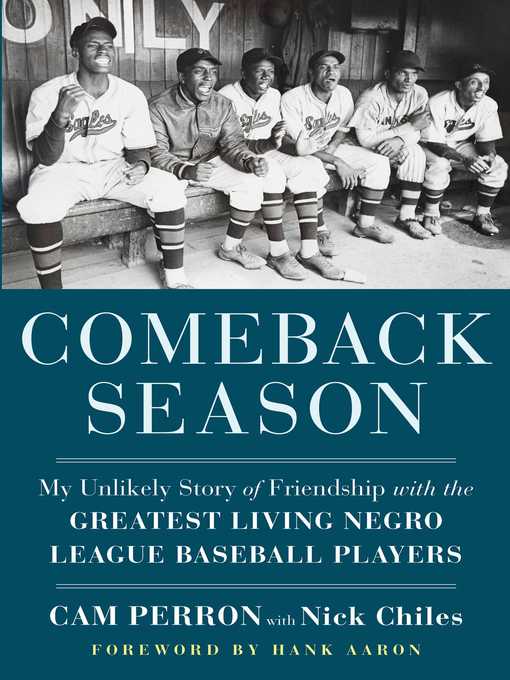
Comeback Season
My Unlikely Story of Friendship with the Greatest Living Negro League Baseball Players
کتاب های مرتبط
- اطلاعات
- نقد و بررسی
- دیدگاه کاربران
نقد و بررسی

February 1, 2021
A fan's notes on the Negro League of baseball lore. "When I was growing up in Mobile, Alabama," writes baseball great Hank Aaron in the foreword, "I taught myself how to hit by swinging at bottle caps with a broomstick." Material conditions didn't improve for him until he joined the Indianapolis Clowns and then the Atlanta Braves. Perron's book is timely, inasmuch as Major League Baseball recently announced that it will include records from the Negro League in its overall statistics. The author, a young White man from the Boston suburbs, has built a formidable collection of artifacts from the time. That collecting instinct was honed over a youthful obsession with Nirvana, for which he learned how to code to build a fan website, as well as a love of old coins, antiques, and other sought-after items. His Negro League collection was built bit by bit, with travels all over the country to interview elderly athletes, interactions that "were personal, meaningful, and with players who had been overlooked by others." Perron's attention to players such as John "Mule" Miles, who "became legendary after he hit a home run in eleven straight games," and Bill Bethea, who worked twice as hard as his teammates until an arm injury halted his pitching career, led to many friendships. Perhaps Perron's greatest accomplishment, apart from building a collecting company and adding tremendously to the history of the Negro League, was to secure MLB pensions for veterans. "It surely sounded too good to be true, like winning the lottery with a ticket you hadn't even purchased," he writes after informing Joe Elliott, a star player from the 1950s, of the windfall. Perron delivers an enthusiastic and detailed account of the players' work, and his, and it's a pleasure to read. Baseball fans of whatever stripe will enjoy Perron's homage to an organization and players too long overlooked.
COPYRIGHT(2021) Kirkus Reviews, ALL RIGHTS RESERVED.

February 15, 2021
While, thankfully, baseball fans can now access a wealth of information on the Negro Leagues--from Robert Peterson's Only the Ball Was White to Mark Ribowsky's A Complete History of the Negro Leagues to Lawrence B. Hogan's Shades of Glory--Cam Perron's story, co-written with Nick Chiles, has a certain sweetness and strength to it. A 12-year-old white kid in suburban Boston, Perron improbably developed a keen interest in the Negro Leagues, first writing to any and all ballplayers from that era to cadge an autograph or other artifacts, then slowly developing close relationships with many of them, helping to connect the players to one another via phone or annual reunions he'd helped arrange, then, most profoundly, facilitating pensions, totaling millions of dollars, for nearly 50 former players, many of them straitened financially. Perron explains his evolution from collector to advocate and, more important, generously shares the extraordinary stories of these last remaining players, often in their own words. For fans, what's not to love?
COPYRIGHT(2021) Booklist, ALL RIGHTS RESERVED.

Starred review from March 1, 2021
The Negro Leagues might not be as well-known as the MLB, but their impact on the sport of baseball is still felt today. In this enthralling debut, Perron, along with journalist Chiles, discusses several outstanding Negro League ballplayers and how the league came to be. Starting in 2007, Perron wrote letters to former players, asking them for their autographs; what he received in return was much more. After writing the letters, he started receiving phone calls from players, which eventually turned into friendships. Players like Bob Mitchell and Mudcat Grant shared their stories of playing baseball and the racism they experienced in the sport. This inspired Perron to organize a reunion while helping to create a Negro League museum in Birmingham, AL. The players' stories shine throughout, and even readers who aren't familiar with the league will enjoy hearing stories of Cool Papa Bell, Randolph Bowe, and Joe Elliot, among others, and how they fought for recognition. VERDICT Baseball fans will thoroughly enjoy this captivating look into a side of the sport they might not know about. This heartfelt book, with a foreword by Hank Aaron, is a must-read, and Perron's personable writing succeeds in giving often overlooked players a voice.--Gus Palas, Ela Area P.L., Lake Zurich, IL
Copyright 2021 Library Journal, LLC Used with permission.

Starred review from April 19, 2021
Perron debuts with an inspiring account of how he came to help preserve the legacy of Negro League veterans. When he was 12 years old in 2007, the author, an avid (and white) baseball card collector, encountered a set featuring players from the Negro League. Intrigued, he began tracking down surviving players through an online forum, and what began as requests for signed memorabilia turned into a series of correspondences between Perron and several of the players. In these conversations, he learned about how their baseball successes were curtailed by racism in Major League Baseball: “They would tell us to our face that they already had enough colored or Cuban ballplayers,” one player recalled. Perron’s research aided in documenting the Negro Leaguers’ playing careers, which helped them secure pensions from the MLB, an overdue compensation that saved many elderly former athletes from destitution. Along the way, Perron was involved in organizing the first annual Negro League Players Reunion and, later, the founding of a Negro League museum. Perron’s ability to channel his childhood interests into something meaningful for others is moving, and his extraordinary account uplifts. Even those who aren’t sports fans will root for this galvanizing story.

























دیدگاه کاربران